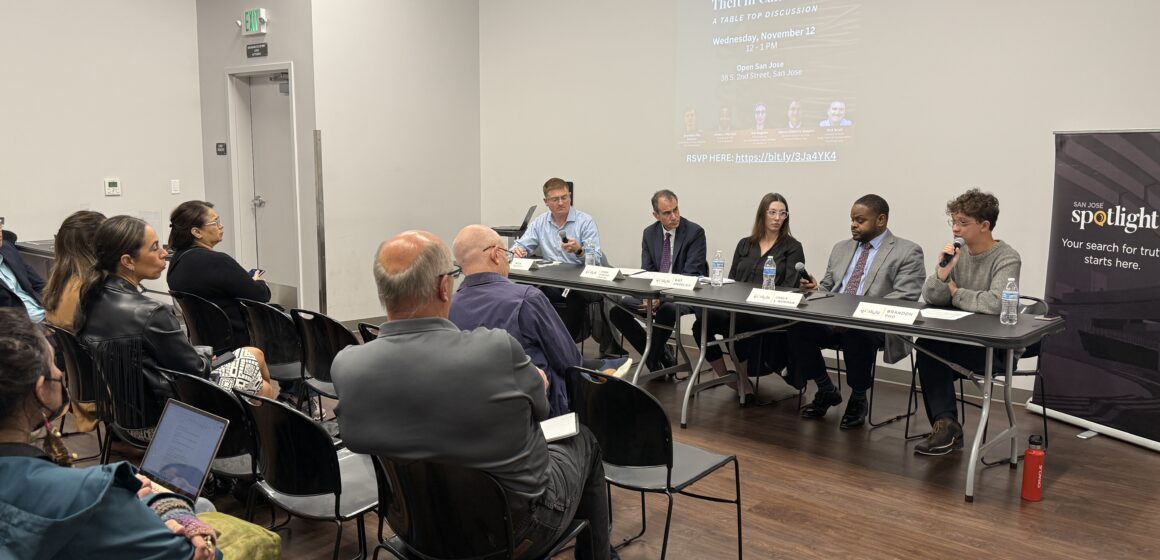Silicon Valley leaders are filling utility boxes with sand, running undercover stings and devoting entire municipal teams to repairing copper wire as rising thefts wreak street light outages and thousands of dollars in property damage.
Those were the insights of a Nov. 12 panel hosted by San José Spotlight, which heard from broadband, business, transportation and law enforcement experts on a problem plaguing street lights, traffic signals and VTA light rail stations. The infrastructure disruptions can mean service delays and less-visible neighborhoods.
It warrants a special focus on San Jose’s 65,000 streetlights and approximately 940 traffic signals, according to Rick Scott, assistant director of San Jose’s Department of Transportation. He’s been with the department for 13 years, but said June 2024 is when thefts began to skyrocket.
“I’d see about 10 to 15 complaints per month about copper wire theft, and then all of a sudden it was about 100 to 150 per month,” he said. “We just got overwhelmed as a city.”
The city has documented about 2,200 incidents since last June and repaired 1,500 of those since then. But there’s still a backlog of about 700 outages.
“It means neighborhoods are going to spot (dysfunctional) street lights, it means people don’t feel safe, and I think that is a huge priority for us to make sure we can repair those as quickly as we can,” Scott said. “The thieves have been pretty clever and have been able to just break the concrete utility box and get to the wire … (but now) when we repair copper wire, we fill the box with sand and then a layer of concrete on the top. So we’ve actually noticed there’s been no, to my knowledge, new outages where we’ve done that.”
Assistant District Attorney James Gibbons-Shapiro said enforcement isn’t solely focused on street-level thieves — but the organized networks buying and reselling copper at higher rates. The material’s high commodity value and ubiquity in everyday infrastructure makes it a lucrative business, especially when copper wire is easy to strip and brace and is poorly secured.
“We need to attack that marketplace … There have been two publicly reported undercover operations from local police in the past few months,” Gibbons-Shapiro said. “If you’re buying stolen copper, the person you might be buying it from might be a police detective.”
Kat Angelov, a policy manager for the San Jose Chamber of Commerce, looks forward to two new laws that will provide other prongs of protection. Assembly Bill 476 takes effect in January and makes it illegal to possess metal from essential infrastructure and requires metal recyclers to keep extensive records for sales they make. Assembly Bill 2371 makes it easier for cities to secure industrial sites with electric fences. The bill went into effect September 2024.
Angelov said businesses feel the hurt directly and through tertiary effects. Downed lights might discourage patrons from being in a certain area. Sometimes, thieves might mistake copper wire for other cables.
“Thieves may take the wrong type of wire and it’ll put down internet service,” Angelov said. “So we hear particularly about small businesses having issues with their internet that’ll go down. It takes hours for a crew to come out and fix it, so then that small business loses four, five, six hours of opportunity and operation.”
 Janus Norman is the president and CEO of Cal Broadband, an industry group that advocates for the development and deployment of broadband infrastructure. Norman said the demand for copper wire as an essential material exacerbates the theft crisis.
Janus Norman is the president and CEO of Cal Broadband, an industry group that advocates for the development and deployment of broadband infrastructure. Norman said the demand for copper wire as an essential material exacerbates the theft crisis.
“If you look at the data, copper prices in 2020 were about $2.80. They increased about 63% now to about $4.55,” Norman said. “There’s also a resale market that you can get from scrap metal dealers that you can vandalize, take infrastructure and then sell it essentially on the black market and see a significant increase of what you would have seen in prior years,”
Panelists said local officials shouldn’t expect to see relief from lowering demand any time soon.
“The price of copper will continue to rise as it is an essential metal for many, many services,” Norman said.
Contact Brandon Pho at [email protected] or @brandonphooo on X.



Leave a Reply
You must be logged in to post a comment.